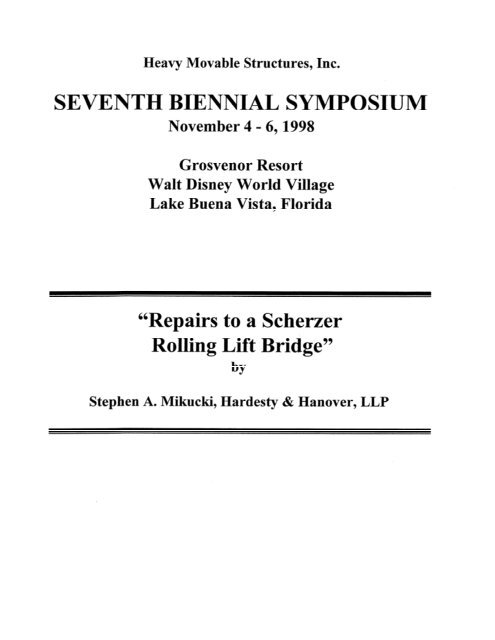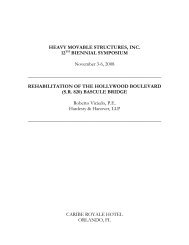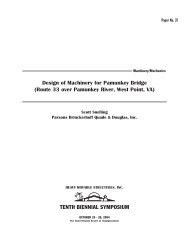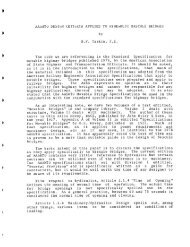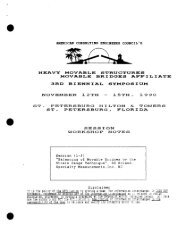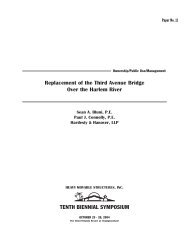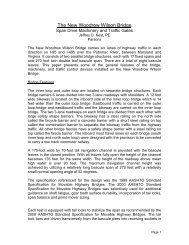Repairs to Scherzer Rolling Lift Bridge - Heavy Movable Structures ...
Repairs to Scherzer Rolling Lift Bridge - Heavy Movable Structures ...
Repairs to Scherzer Rolling Lift Bridge - Heavy Movable Structures ...
Create successful ePaper yourself
Turn your PDF publications into a flip-book with our unique Google optimized e-Paper software.
REPAIRS TO A SCHERZERROLLING LIFT BRIDGEClient:Designers:Contrac<strong>to</strong>rs:AMTRAKHARDESTY & HANOVER, LLPCIANBRO CORPORATIONPrepared by:Stephen A. Mikucki, P.E.Hardesty & Hanover, LLP1501 BroadwayNew York, New York 10036
IPROJECT BACKGROUNDI A - <strong>Bridge</strong> Specifications -The <strong>Rolling</strong> <strong>Lift</strong> <strong>Bridge</strong> over the Connecticut hver in Old Saybrook, Connecticut is a twotrack rail structure built in 1907 as a part of the Northeast Corridor, and is still the busiest railcorridor in the country. ( See Figure 1 ) It was designed in 1905 for the Shore Line Division of theNYNH & H.R.R. Co. by the <strong>Scherzer</strong> <strong>Rolling</strong> <strong>Lift</strong> <strong>Bridge</strong> Co. of Chicago and bears manytrademarks of its type. The structure is now owned and operated by AMTRAK and heavily used forboth passenger and freight rail traffic The span is 16 1 feet, providing a 137.5 feet navigable channelwhen raised.- ..L. . v. .?.............. . . .SPAN IN OPEN.... ... /" p o s ~ r r o ~. .". ' .. .I.-,'Ḷ :, ' '---.. . . ........S. "1. 4-' ................) .................i ,.-OPERITING FAZHI$E?,Yi :. ..$9 UXI'1ViOPENING ,I : I:SEMEW? GiRDEiiTXUD PUTESI ; ] . .- 48 I: , ---cl -1 4-16:' a' ~49.01lnl , 18'-0. ~11,50=1 ..SOU 6 - ROLLING 1I'T 3ASC6.h SPAN IPIEX 8 PIER 6 PIER 7ZLEVATTONTRICK GiXOEPTiim ?UTESFigure 1 - Elevation of <strong>Rolling</strong> <strong>Lift</strong> Bascule <strong>Bridge</strong> over the Connecticut River
I B - <strong>Rolling</strong> <strong>Lift</strong> Description-The basic concept of a rolling lift bridge is similar <strong>to</strong> a more traditional bascule bridge, however inths type, the center of gravity of the moving leaf, is allowed <strong>to</strong> translate horizontally, while thecurved bot<strong>to</strong>m plate of the main bascule girder, the segmental girder, rolls back on flat tread platessecured <strong>to</strong> the substructure. ( See figure 2 ) The tread plates are aligned <strong>to</strong> each other by means oflugs - on the bot<strong>to</strong>m flat plate which key in<strong>to</strong> pockets on the upper segmental plate These lugs alsosupply resistance <strong>to</strong> lateral forces during the roll.Figure 2 - Typical Section through a <strong>Rolling</strong> <strong>Lift</strong> Bascule <strong>Bridge</strong>(Reproduced from <strong>Movable</strong> and Long Span <strong>Bridge</strong>s, Hoole and Kinne)
I C - General Problems -Over the years of heavy use for rail traffic, the Old Saybrook bridge was subject <strong>to</strong> theproblems inherent <strong>to</strong> many rolling lift bascule bridges 'Walking' of the leaf on the track created highbearing stresses resulting in deformations and damage <strong>to</strong> the lugs and pockets on segmental and trackgirder tread plates Wear <strong>to</strong> the tread plates as well as misalignment of the existing rack segmentshave systematically damaged the operating machinery <strong>to</strong> a point where emergency repair wasrequired
nEXISTING PROBLEMS & DESIGN CONSIDERATIONS11 A - Tread plates -Upon inspection, the tread plates were excessively worn with numerous cracks, especially atthe lug pockets. During span operation, the lugs had periodically been pulled out of the flat treadplate. The lugs were originally mounted by use of a press fit. The contact surfaces of the tread platesexhibited rippling, as a result of cold working of the steel during operation The flattening of thetread plates widened the plate cross section, inducing shear loading on the mounting bolts. The boltsrequired periodic re-<strong>to</strong>rquing, or replacement due <strong>to</strong> the extreme shear loadsI1 B - Operating Machinery -The existing operating machinery on the bridge was installed as part of the Northeast ComdorImprovement Project in the early 1980's. Combined wear of the plates averaged 114 inch from theiroriginal thickness, which dropped the movable span in elevation With the rack segments mountedon the fixed approach span <strong>to</strong>wers, the change in elevation caused the main drive pinions <strong>to</strong> 'bot<strong>to</strong>mout' in the rack. This resulted in hgh <strong>to</strong>oth contact stresses on the gear teeth, bending in the pinionshafts and excessive radial loads on the pinion shaft bearings. The operating machinery whichnormally carries machinery loads only was now carrying a portion of the span dead load.The main pinion gears were translating off their shafts and were obviously misaligned asindicated by the abnormal wear patterns. AMTRAK personnel reported that this had occurred soonafter installation. Operating machinery is not designed for high transverse loading, and thereforecomponents began <strong>to</strong> fail. In addition <strong>to</strong> the pinions translating off their shafts, the lateral loadingcaused oscillations on the shaft mounted reducers. The result was a bending load applied <strong>to</strong> the<strong>to</strong>rque arm which is designed for tension and compression loads only. The <strong>to</strong>rque arm on the southside had failed at the threaded portion which resulted in an unsupported secondary reducer.AMTRAK personnel replaced the failed <strong>to</strong>rque arm with steel plates used as links. Several mountingbolts for the main pinion bearing housing had failed and the housing was observed <strong>to</strong> move radiallywithin the structural sleeve during operation.II C - Determining Cause & Design Improvements -In researching shop drawings for the existing bridge, it was discovered that the tread plateshave been replaced about every twenty years due <strong>to</strong> wear. The reason for the frequent replacementsof the tread plates is their unusually thin cross section given the high dead loads of such a largebridge. Currently AREA standards require the tread plates <strong>to</strong> be a minimum of 5 l/2 inches thick fora bridge this large. The existing curved and flat plates are 2 and 2 114 inches thick respectively, whichis less than half the required thickness.
The thin cross section of the plates was not enough <strong>to</strong> resist the flattening that occurredduring operation. Increasing the thickness of the tread plates was not possible without majormodifications <strong>to</strong> the segmental girder and/or elevation of the track girder It was decided <strong>to</strong> maintainthe same thickness, but <strong>to</strong> replace the tread plate with hlgher strength steel in order <strong>to</strong> reduce the rateof wearTo improve the alignment of the rolling span during operation, the lugs were tapered. Thelugs were also designed with a countersunk head on the underside of the flat plate in order <strong>to</strong>eliminate <strong>to</strong> possibilities of the lugs pulling out,The worn tread plates were not the only cause for the abnormal loading <strong>to</strong> the operatingmachinery. It was apparent through field measurements that the rack segments were installedincorrectly during the 1985 replacement of the bridge machinery. Not only were the rack segmentsinstalled non-parallel <strong>to</strong> the translation of the pinion travel, but were also not parallel with respect <strong>to</strong>each other. This caused a cross mesh of the main pinion with the rack segments, which results in atransverse loads on the main pinion. The transverse loading forced the pinion off the shaft duringspan operation. At the time of inspection the pinion had walked of approximately 5 inches on thenorth side and 3 inches on the south side.Considering the extent of damage <strong>to</strong> the existing components and the limited marine and railclosures that would be allowed, replacement of the damaged machinery was the only option. Theonly remedy for the poor alignment was <strong>to</strong> realign the rack segments and specify critical precisionsurveying of the structure for the installation of the operating machinery.The cause of failure for the south reducer <strong>to</strong>rque arm is also due <strong>to</strong> the transverse force whichinduced a bending load on the <strong>to</strong>rque arm. The <strong>to</strong>rque arm had no provisions for bending so theforces lead <strong>to</strong> a fatigue failure at the threaded portion.The new <strong>to</strong>rque arms were installed with spherical rod end bearings that will allow for anybending load caused by the pinion that may occur over time.II D - Rail & Marine Traffic -The main logistical problem in planning the rehabilitation was the fact that this bridge carriesall the New York <strong>to</strong> Bos<strong>to</strong>n rail traffic, with no existing bypasses. Disruption of rail traffic would beextremely costly. Marine traffic is also heavy since the bridge is located at the mouth of theConnecticut River, and is the only marine route <strong>to</strong> Hartford. The construction would have <strong>to</strong> bescheduled afier the pleasure craft season ( between May and Oc<strong>to</strong>ber ), and not during the holidayschedule between Columbus day and New Years. This left only between January through April. Themonths of March and April were chosen in order <strong>to</strong> avoid harsh winter weather of January andFebruary. Any closure would need <strong>to</strong> allow for periodic openings <strong>to</strong> allow for passage of he1 oilbarges traveling <strong>to</strong> Hartford.
N E - Construction Scheduling -The rehabilitation schedule ultimately chosen called for removal and replacement of the rearcurved tread plates during a three day closure, four days of an operational bridge <strong>to</strong> allow for bargetraffic, and a three day navigational closure for the rear flat tread plates. This would be referred <strong>to</strong>as phase Ia & Ib respectivelyAfter stage Ia and Ib were complete, the Contrac<strong>to</strong>r had a week and a half <strong>to</strong> prepare for thecritical front tread plate replacement, which would be performed in a 39 hour rail closure with thebridge in the raised position. This 39 hour rail closure would be referred <strong>to</strong> as stage 11, and was morecritical since it required Arntrak <strong>to</strong> provide bus service between New Haven and New London trainstations. Bus service would cost approximately $450,000 for 39 hours. Additional costs would benecessary should the installation run in<strong>to</strong> any delays.After stage I1 was complete, the Contrac<strong>to</strong>r would have another 1 '/2 weeks <strong>to</strong> prepare forthe 10 day navigational closure for the partial machinery installation, which included the racksegments, the main pinions and shafts, the secondary reducers and <strong>to</strong>rque arms. Critical surveyingwas performed <strong>to</strong> measure the travel of the main pinions through out full travel. Ths was necessary<strong>to</strong> determine the placement of the rack segments.
111 A - Phase I & II-Since the existing tread plate mounting bolt locations varied +/-I18 inch from the theoreticalbolt centerline, each mounting bolt hole would need <strong>to</strong> be located in the field based on the locationof the holes in the track and segmental girder flanges. This required the tread plates <strong>to</strong> be preliminarilyaligned and clamped in place, each of the 8001 bolts were punch marked <strong>to</strong> locate their exactlocation, then the plate was removed and bolt holes drilled Having <strong>to</strong> drill the 8001- bolt holes in thehigh strength steel plate, within the limited amount of time became a concern The Contrac<strong>to</strong>r drilledsample pieces and timed the operation <strong>to</strong> be approximately two minutes from per bolt, using atitanium nitride coated drill bit and a magnetic based drill. This process proved <strong>to</strong> be adequate,causing no delays <strong>to</strong> the tight construction scheduleSince the existing tread plates had been compressed <strong>to</strong> a thinner cross section, a step wascreated between the new and old plates, which was critical during bridge operation between stagesI and 11. Therefore the exiting plates were ramped <strong>to</strong> match the new tread plate elevation using shimsbetween the girder flange and tread plate over a two foot transitional distance.The most critical alignment was mating the curved and flat plates, and how <strong>to</strong> establish thetravel existing of the tread plates. The existing lugs and pockets had been heavily dis<strong>to</strong>rted <strong>to</strong> thepoint that no datum line could be established. The Contrac<strong>to</strong>r developed a system <strong>to</strong> measure thebridge alignment during the operation. The travel was recorded by using an offset bracket attached<strong>to</strong> the track girder of the approach span and segmental girder of the movable span. The offsetbrackets served as a datum point for alignment of the new tread plates.The removal of the north rear curved tread plate revealed , a '/z step in the se,gnental girderlocated at the rear portion of the new tread plate. This was created during the segmental girderrepair performed in the early 197O9s, when the radii of the north girder was corrected <strong>to</strong> match thesouth. The splice was s<strong>to</strong>pped at that point, since any hrther would require modification ofcomplicated structural connections that supported the overhead counterweight. It was an unforseencondition. It was decided <strong>to</strong> shm the gap between the girder and tread plate over approximately 2feet transitional length. During an earlier rehabilitation in the 1950ts, the span travel was limited <strong>to</strong>59 degrees, since the bridge travel does not contact the step on the tread plate, this does not effectbridge operation.111 B - Phase III-Once the tread plates were installed, an accurate survey of the pinion travel had <strong>to</strong> bemeasured. The survey had <strong>to</strong> be detailed enough <strong>to</strong> provide enough information <strong>to</strong> set the racksegments <strong>to</strong> the bridge travel both in elevation and plan. This was extremely critical since once themachinery was set there was little room for adjustment. Only the rack elevations could be modifiedwith the addition of steel shim.
The new rack support angles location based on the survey deviated greatly from the existinglocation, since the existing rack segments were out of alignment at the north side The difference wasso much that the new angles would interfere with structural connections at several locations Therack support angles had <strong>to</strong> be cus<strong>to</strong>mly fit around the gusset plates at those interference pointsSince the main pinion elevation depends on the track girder elevation and the segmental girderradii, the pinion elevation deviated a <strong>to</strong>tal of 1/4 inch throughout the entire travel of the opening Itwas decided <strong>to</strong> set the rack segments at the best fit with the pinion pitch line The rack segmentswere set so the two high points were the deepest engagement with the pinion. The pinion teeth ( witha circular pitch of greater than 4 inches ) were large enough and strong enough <strong>to</strong> compensate forthe varying pinion travel.
IVRESULTSPhase I as expected served as a learning phase for the actual field details <strong>to</strong> determine theplacement of the tread plates. The methods and time critical items learned were addressed and refinedfor the critical phase I1 construction.Phase I1 was a long and busy 39 hours with much anticipation for the end result Due <strong>to</strong> ElNina, 1998 was the mildest winter in recent his<strong>to</strong>ry, but in late March during the scheduled weekendfor rail closure, the only winter s<strong>to</strong>rm of the year struck Snow, sleet and high winds were presentfor the majority of the 39 hour closure The bridge offered little protection from the elements, so theContrac<strong>to</strong>r rigged canvas <strong>to</strong> provide some sort of shelter Phase 11 ended when the span lowered forthe first time, without requiring the centering devices <strong>to</strong> align the span at the <strong>to</strong>e The track railelevations at the heel were adjusted for the new tread plate thickness There was no delay <strong>to</strong> the trainschedulePhase I11 incurred few minor field adjustments, with the operating machinery installed andaligned correctly. The pinion/ rack <strong>to</strong>oth alignment was better than expected throughout the travelof the bridge, thanks <strong>to</strong> the precision survey performed by the millwrights.Throughout the project the Contrac<strong>to</strong>r as well as Amtrak construction personnel exhibitedexcellent decision making and coordination that resulted in a successhl emergency repair.


